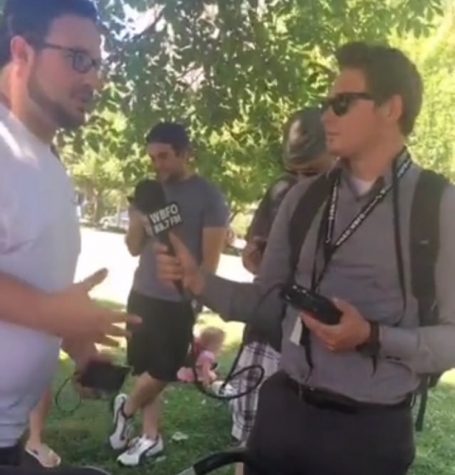The misidentification of children with intellectual disabilities
May 18, 2021
According to the U.S. Department of Education, 13.8 percent of school students are Black Americans, but 17.9 percent of Black Americans are identified with an intellectual disability. With such a statistic, it makes you wonder if these findings are 100 percent accurate. In fact, there are some caveats to the ways in which children are diagnosed with an intellectual disability.
Historically speaking, there have been biases in the tests meant to prove that one has an intellectual disability.
One way disabilities are discovered and confirmed is through a standardized test. Standardized tests are considered to be a reliable method of finding areas of academic strength and improvement for students, as well as being a good tool for teacher evaluation.
The caveat is that it’s generally a one-size-fits all method of testing. It’s meant to determine who’s good at taking a test. Families and districts with more time and money available have more of an opportunity to teach their children how to answer test questions correctly.
It’s possible to have a 4.0 GPA in high school, yet perform poorly on SATs or ACTs, for example. This has a negative impact on college admissions, but is no indication of one’s intelligence level.
The accuracy of this test leaves out those who don’t know how to take a test, or those with unique abilities. The reason why is because grades are based on a bell curve. This is where test scores are 50 percent above or below the average.
According to Dr. Raquel Schmidt, professor of Exceptional Education studies at Buffalo State College, the intelligence quotient tests used to gauge a student’s intellectual abilities have questions which are slanted in the direction of White American cultural values. Failure of these tests meant that children would be classified as having a disability.
“When taking these tests, some of these questions are based on the white middle class experience. The students are answering questions about terms they’ve never heard of, and when they get the answer wrong, the students may be diagnosed with a disability.”
What she’s referring to is the Black Intelligence Test of Cultural Homogeneity. It was a study conducted by psychologist Dr. Robert Williams in 1972. This test pointed out the language barriers present in IQ tests. The language and cultural differences of the students account for the large gaps in IQ test scores between Black and White Students.
When Black students were asked to define terms commonly used in Black ghettos, they scored well. White students who were given the same task performed poorly. This indicated that the tests meant to determine one’s intelligence level are rooted in racial and ethnic biases that heavily favor the dominant culture.
Some people in this field see equity in the process where students are identified with an intellectual disability. I interviewed a Buffalo State student who is currently a student-teacher at a predominantly white, Catholic private school.
She has said that the process is “pretty accurate as teachers spend 6 hours with these students and they come to understand them well.” In addition, she said “All students are treated and viewed equally and fairly in this process, regardless of race, sex, or gender identity.”
According to Dr. Gilset Colon, professor of Exceptional Education Studies at Buffalo State College, Hispanic and Latino children have been misidentified for having an intellectual disability because of language and cultural differences.
“The IQ tests were only administered in English. It was hard to tell if the students were struggling with a language barrier or if they had an intellectual disability.”
Colon goes on to say that in the 60s and 70s, Black and Hispanic students in inner cities were disproportionately identified as having a disability because of the tests. Then these students would be taught by a predominately White faculty, who have little to no cultural knowledge of the community they’re teaching.
To this day, the teaching workforce is 80-90 percent white, while the public schools they teach at are majority minority.
On the flip side, there’s the gifted category. There’s plenty of criteria of who qualifies as gifted. Some common characteristics include having exceptional talent, high achievement, and regularly standing out in class.
According to Fatherly, White children and children from wealthy families are more likely to be identified as gifted. Over 60 percent of White students in public schools have been identified as gifted, despite only making up 50 percent of the school population. Black students made up 9 percent of gifted students, despite 15 percent of the student population. Latino students only make up 18 percent of students in the gifted category, while comprising 26 percent of the student population.
A large reason for this is because the test to determine if students are gifted still caters to the experiences of White middle class students, and it consistently weeds out students of color. Black and Latino students seldom get into these programs, and are more likely to get suspended by preschool.
The IQ test in particular is still used. Today, experts on the matter agree that this test is not a good indicator of one’s intelligence or if a kid is gifted. Psychologist and eugenicist Lewis Terman created this test, and it was instrumental in the foundation of the gifted label.
The gifted label was popularized in 1957 after the Soviet Union launched the Sputnik. A court order forced Buffalo public schools to integrate and implement the gifted label in their schools in 1976.
The public school districts created magnet programs to encourage White families to enroll their children into predominantly Black public schools. School districts created robust after school programs, school lunch programs, and extracurricular activities to bring people to the schools and create the best experience for everyone.
PS 64 Frederick Law Olmsted is a public school that was part of the reform. Their gifted program was reformed and allowed easier admission into the program. The attendance zone was widened, and a prep program was created for non-gifted students so more children could have this opportunity. This made Buffalo a great example of successful implementation of integration.
This system came to an end when federal court supervision of this program stopped in 1995, and a White family successfully sued City Honors for their child not being admitted into the school, claiming reverse discrimination. As a result, the Olmsted gifted program began to operate in ways that were biased against low-income families, such as having to take their children to a one-on-one IQ test with a psychologist on a Saturday, despite the fact that most low-income families work on Saturday.
As schools become more diverse, the teacher workforce remains largely made-up of White women. These teachers are most likely ill-equipped to cater to the teaching needs and styles of students of color. They lack the cultural familiarity necessary to teach a diverse population.
There’s a blind spot when it comes to linguistic bias. Students of color are asked to define terms that are commonly associated with the white middle class experience. When they fail on this point, they are not identified as gifted. This program heavily privileges white students.
According to Fatherly, there also seems to be a confusion between the definitions of a learning disability and learning styles. Students vary between learning styles in the classroom. Some may be visual, some may be auditory, tactile, kinesthetic and more. Accommodations must be made for that. If a teacher has only one style of teaching, it is not equitable, and it leads to achievement gaps.
The best way to approach this problem is to reform the way the disabilities are diagnosed. Anyone in a child’s life may notice behavior that raises concern, but it requires a professional, holistic approach to make the decision.
It requires evaluation of the student in all areas of life and academics. It also requires an unanimous understanding of the limitations the standardized tests offer when determining if one has an intellectual disability.














